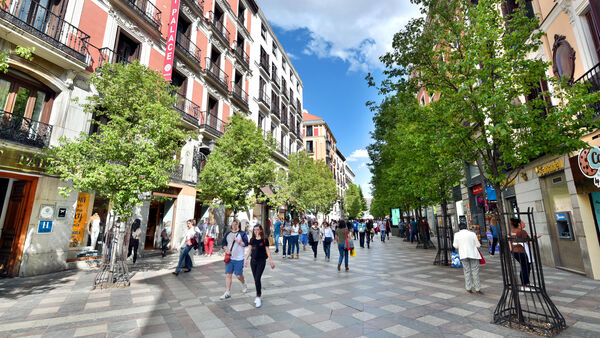Madrid’s Outdoor Delights
By Rick Steves
Spain's capital, like its population, is relatively young. In medieval times, Madrid was just another village, but under several successive kings it transformed to a European capital. Today the country's hub is the upbeat, vibrant home of more than 3 million people.
As the city grew, it made room for its newcomers with a sprawl of modern districts surrounding its fascinating, easy-to-navigate historic core. Today, Madrid feels orderly and welcoming. Massive urban-improvement projects — new parks, pedestrianized streets, and revamped transit — continue to make the city increasingly livable.
You'll find wonderful car-free areas crossing the city from the Prado Museum to the Royal Palace. Strolling along the pedestrianized Calle de las Huertas or Calle del Arenal, you can see how the investment turned once-ramshackle zones into trendy ones. Posts were installed to keep cars off sidewalks, making the streets safer after dark, and old buildings were restored, helping to preserve the city's grandeur and intimate charm.
Simply walking these car-free streets seems to be the way the Madrileños spend their evenings. On hot summer nights, entire families stroll the streets even past midnight — licking ice cream, greeting their neighbors, and enjoying beer and tapas in a series of bars. To join them, wander from Puerta del Sol, the lively central square, to the historic cobbled Plaza Mayor, or along the Calle de las Huertas, the pedestrianized street leading to the Prado.
For maximum fun, keep walking and go mobile for dinner: Do the tapeo, going from one bar to the next, munching, drinking, and socializing. You can find tapas bars almost everywhere in Madrid, but areas in the city center are particularly rewarding for a bar-crawl meal: The two-block stretch on Calle de Jesús (near the Prado) is the easiest, with several wonderful and diverse places. I never tire of this edible scavenger hunt, where I collect small portions of seafood, salads, meat-filled pastries, and deep-fried tasties, and piece them together for a light evening meal.
Spain has a reputation for partying very late, with night spots not closing until offices open in the morning. If you're people-watching early in the morning, it can be hard to know who is finishing their day and who's just starting it. Even if you're not a party animal after midnight, make a point to be out with the happy masses, luxuriating in the cool evening air.
One reason people stay out late, especially in summer, is to escape the heat of the day. I often think people who talk about the weather and traffic have nothing else of greater interest on their minds. But here in the lofty and overheated interior of Spain, even people with plenty to say talk about the weather in this era of climate change. The last time I was here in summer, I caught myself assessing restaurants by the quality of their air-conditioning. I saw poor locals, refugees from the heat, lying like lizards in the shade.
When it's sizzling, Madrileños head to Retiro Park, a 300-acre green-and-breezy escape. It's a picnic-friendly place where you can hopscotch through a mosaic of lovers, families, skateboarders, expert bench-sitters, and pets walking their masters.
Once the private domain of royalty, this majestic park has been a favorite of Madrid's commoners since King Charles III (of Spain) decided to share it with his subjects in the late 18th century. The lake at its center is filled with rented rowboats, and on weekends the surrounding area becomes a carnival of fun with jugglers, puppeteers, and lots of local color.
Nearby, just south of the Prado, is the lush and fragrant Royal Botanical Garden. Wander through this sculpted oasis to enjoy its collection of trees from around the world, also established by Charles III.
For great views and an ancient temple, head to the Parque de la Montaña. In 1968, the Egyptian government, in gratitude for Spain's help in rescuing monuments threatened by rising waters above the Aswan Dam, gave its Temple de Debod to the city of Madrid. Consequently, Madrid is the only place I can think of in Europe where you can actually wander through an intact original Egyptian temple — complete with fine carved reliefs from 200 BC. It's in a romantic park that locals love for its memorable panoramas, especially at sunset.
Throughout Europe, energetic governments are renewing green space and turning formerly car-congested wastelands into public spaces. To experience today's Madrid, take time away from indoor attractions and relish the exterior of this inviting city.

